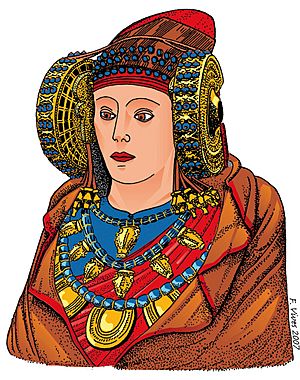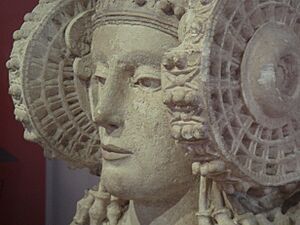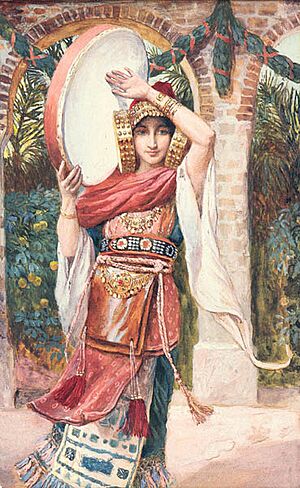Lady of Elche facts for kids
Quick facts for kids Lady of Elche |
|
|---|---|
| Dama de Elche | |
 |
|
| Type | Bust |
| Material | Limestone |
| Height | 56 cm (22 in) |
| Width | 45 cm (18 in) |
| Depth | 37 cm (15 in) |
| Weight | 65.08 kg (143.5 lb) |
| Discovered | 1897 La Alcudia, Elche |
| Discovered by | Manuel Campello Esclápez |
| Place | National Archaeological Museum |
| Culture | Iberians |
The Lady of Elche (called Dama de Elche in Spanish and Dama d'Elx in Valencian) is a famous ancient limestone sculpture. It's a bust, meaning it shows only the head and upper chest of a person. This amazing artwork was found in 1897 at a place called La Alcudia, near Elche, Spain. Today, you can see it at the National Archaeological Museum of Spain in Madrid.
Most experts believe the Lady of Elche was made by the Iberians, an ancient people who lived in Spain. It dates back to the 4th century BC, which is over 2,400 years ago! The style of the sculpture also shows some influences from ancient Greek art. Some people think the Lady of Elche might be linked to Tanit, a goddess worshipped by the Carthaginians and Iberians.
Contents
What the Sculpture Looks Like
The Lady of Elche shows a woman with a very fancy headdress. She also has large, wheel-shaped coils on each side of her face. These coils are called rodetes. The sculpture was originally painted with bright colors, but most of the paint has faded over time.
There's an opening at the back of the sculpture. This suggests it might have been used as a funerary urn. This means it could have held the ashes of someone who had passed away.
Other ancient Iberian sculptures look similar to the Lady of Elche. These include the Lady of Guardamar and the Lady of Baza. The Lady of Guardamar also has the unique wheel-like rodetes and necklaces. While the Lady of Elche is a bust, some clues suggest it might have once been part of a full-body statue. This would be similar to the seated Lady of Baza or the standing Gran Dama Oferente. These three famous Iberian sculptures are all displayed in the same museum in Madrid.
How the Lady of Elche Was Found
The Lady of Elche was discovered on August 4, 1897. A young worker named Manuel Campello Esclapez found it. However, another story says Antonio Maciá found the bust. This happened while farm workers were clearing land for farming at the archaeological site of La Alcudia. Locals quickly nicknamed the sculpture "Reina Mora" or "Moorish Queen."
Today, the place where the bust was found is an important archaeological site. Experts have found signs of ancient Iberian and Roman settlements there. They've also found Roman houses, walls, and mosaics. One mosaic even shows Saint Abdon, from a Christian church built in the 5th century.
The owner of the farm, Dr. Campello, was married to Asunción Ibarra. Her father, Aureliano Ibarra Manzoni, was a humanist and amateur archeologist. He had collected many Iberian objects from his land. He wanted his collection to be sold to the Real Academia de la Historia after his daughter's death. He hoped it would end up in the National Archaeological Museum. The family put the Lady of Elche on their balcony so everyone in Elche could see it.
A local record keeper, Don Pedro Ibarra, invited a French archaeologist named Pierre Paris to see the Mystery Play of Elche. When Pierre Paris saw the Lady of Elche, he knew it was very valuable. He told the Louvre museum in Paris about it. The Louvre offered a lot of money for the time: 4,000 francs. The sculpture was bought and sent to the Louvre on August 30, 1897.
The Lady's Journey Home
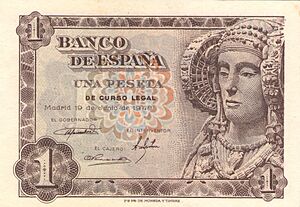
For 40 years, the Lady of Elche was displayed at the Louvre in France. When World War II started in 1939, the sculpture was moved to a safer place, the castle of Montauban. Later, the French government and Spain's government made a deal. In 1941, the Lady of Elche was returned to Spain. This was part of an exchange of artworks between the two countries. Spain received other important pieces, and in return, France received some Spanish paintings.
Since 1941, the Lady of Elche has been officially owned by the Museo del Prado in Madrid. Its discovery made many people interested in ancient Iberian culture. The Lady of Elche even appeared on a 1948 Spanish one-peseta banknote. In 1971, it was moved from the Prado to the National Archaeological Museum of Spain, where it is still displayed today.
Special Exhibitions in Elche
The Dama de Elche has returned to its hometown of Elche a few times for special events. In 1965, it came back for a short visit to celebrate the 700th anniversary of the Mystery Play of Elche.
Then, in 2006, the Spanish Minister of Culture decided to let the Lady visit Elche again. From May to November 2006, the Dama de Elche was the main attraction at the opening of the Museum of Archaeology and History of Elche. It was also part of an exhibition called From Ilici to Elx, 2500 Years of History. After this special exhibition, an exact copy of the sculpture was put on display.
Is It Real? The Forgery Debate
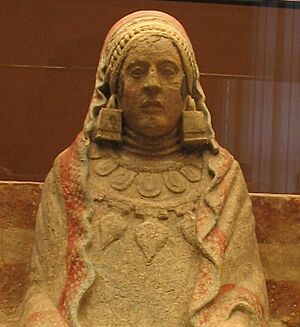
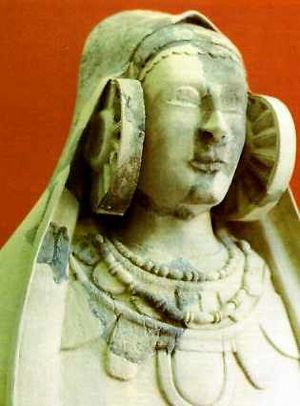
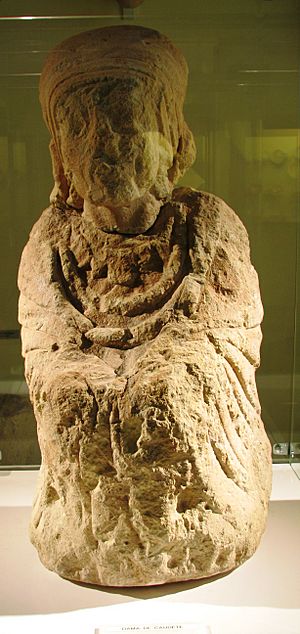
In 1906, some people started to wonder if the Lady of Elche was a fake. An archaeologist named José Ramón Mélida wrote an essay suggesting it might not be real.
Later, in 1995, art historian John F. Moffitt published a book arguing that the statue was a forgery. He said its style was different from other ancient Iberian sculptures. Moffitt thought a known forger might have created it for the landowner, just before the French archaeologist Pierre Paris visited and bought it. He believed it was part of a time when many fake artworks were being made.
However, most experts in Spanish archaeology disagree with Moffitt. They believe the Lady of Elche is a genuine ancient Iberian artwork. Antonio Uriarte from the University of Madrid said that research has shown the Lady fits well with other Iberian sculptures. He pointed out that many features of the Lady, which were not understood when it was found, have been confirmed by later discoveries. For example, the use of paint on Iberian sculptures was not known when the Lady appeared, but it has since been confirmed.
A study in 2005 by the Consejo Superior de Investigaciones Científicas (CSIC) looked at tiny paint particles on the statue. They found that the pigments were consistent with ancient materials, and no modern paints were found.
Throughout the 20th century, other similar Iberian busts were found in Spain. These include the Lady of Baza, the Lady of Caudete, and the Lady of Guardamar. These discoveries helped show that the Lady of Elche's style was not unique.
In 2011, María Pilar de Luxán, who led the 2005 study, analyzed tiny particles from the hole in the back of the Dama de Elche. Using special microscopes, she found that the particles were from human bone ashes. They matched ashes from the Iberian period. This discovery strongly suggests the statue was indeed used as a funerary urn by the Iberians. This finding helps prove its ancient age and its original purpose.
In 2017, Sonia Gutiérrez Llore, an archaeology professor, noted that the story around the sculpture has become an "idealized, national symbol." She said that some parts of its history have been simplified or ignored, but that this version has become the widely accepted truth.
The Lady in Modern Culture
The Lady of Elche is seen as a symbol of ancient Phoenicia at the Alexander Hamilton Custom House in the USA.
French artist James Tissot used the Lady of Elche as inspiration for figures in some of his paintings around the turn of the 20th century.
As mentioned, the Dama de Elche was featured on the 1948 1 Peseta banknote.
The Dama de Elche also appears in William Gaddis's 1955 novel The Recognitions. In the book, a character named Wyatt Gwyon looks at a one-peseta note and calls the engraving of the bust a "beautiful thing."
A large sculpture called "La Dama Ibérica," inspired by the Dama de Elche, was created by Spanish sculptor Manolo Valdés in 2007. It stands in a major intersection in Valencia, Spain.
In the 2022 Marvel Cinematic Universe film Thor: Love and Thunder, the Lady of Elche appears as one of the gods invited to Omnipotence City. She is played by Nicole Milinkovic.
See also
 In Spanish: Dama de Elche para niños
In Spanish: Dama de Elche para niños


